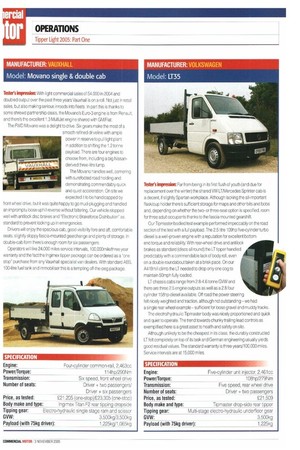Model: LT35
Page 50

If you've noticed an error in this article please click here to report it so we can fix it.
Tester's impression: Far from being in its first flush of youth (and due for replacement over the winter) the shared VW LT/Mercedes Sprinter cab is a decent, if slightly Spartan workplace. Although lacking the all-important flask/cup holder there's sufficient storage for maps and other bits and bobs and, depending on whether the twoor three-seat option is specified, room for three adult occupants thanks to the fascia mounted gearshift.
Our Tipmaster-bodied test example performed impeccably on the road section of the test with a full payload. The 2.5 litre 109hp five-cylinder turbo diesel is a well-proven engine with a reputation for excellent bottom end torque and reliability. With rear-wheel drive and antilock brakes as standard (discs all round) the LT tipper handled predictably with a commendable lack of body roll, even on a double roundabout taken at a brisk pace. On our A419 hill climb the LT needed to drop only one clog to maintain 50mph fully loaded.
LT chassis cabs range from 2.8-4,6 tonne GVW and there are three 2.5 engine outputs as well as a 2.8 four cylinder 158hp diesel available. Off road the power steering felt nicely weighted and traction, although not outstanding —we had a single rear wheel example — sufficient for loose gravel and muddy tracks.
The electro/hydraulic Tipmaster body was nicely proportioned and quick and quiet to operate. The trend towards chunky trailing lead controls as exemplified here is a great asset to health and safety on site.
Although unlikely to be the cheapest in its class, the durably constructed LT felt completely on top of its task and German engineering usually yields good residual values. The standard warranty is three years/100,000 miles. Service intervals are at 15,000 miles.










































































































































































































